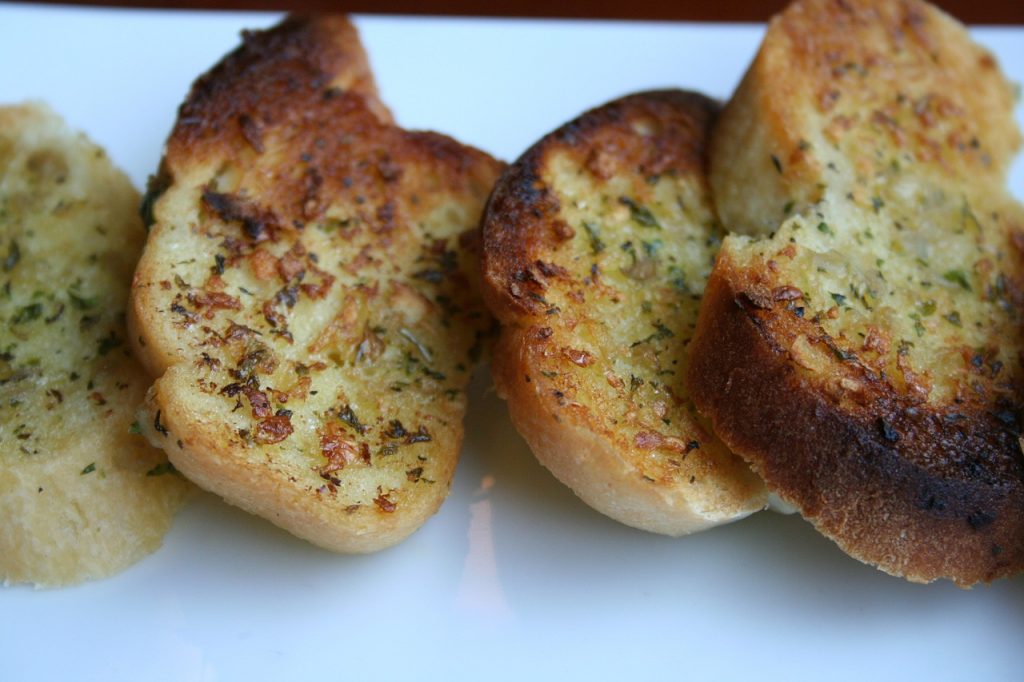
Garlic bread is one of the easiest bread to make. It is usually suitable for many occasions or regular dinner. But sometimes you tend to make more garlic bread than what you can eat. In this case, you might end up asking yourself whether or not reheating garlic bread is safe.
So, can you reheat garlic bread? Yes, you can reheat garlic bread if necessary. Just wrap the bread in foil and put it in the oven for about 10 to 15 minutes. You can use an oven, stovetop, and microwave. If you want to do it quickly, use the microwave. But if you want the bread to be a little bit soft, use the stovetop.
There is no general rule as to how you can reheat garlic bread. Just like other bread, the time needed to reheat the bread depends on your personal taste. Some people love golden brown so they tend to heat it longer.
What I recommend is reheat garlic bread depending on your taste preference. Unless you have visitors you need the bread to offer to, you might want to consider their taste too.
What is the Best Way to Reheat Garlic Bread?
Well, there many ways you can reheat garlic bread. Generally, all of them are simple and quick. In this post, I will share with you three common ways you can reheat garlic bread.
Here are the few ways you can reheat garlic bread:
1. Using the oven
2. Using the microwave
3. Using the stovetop
Each of the ways listed above involves a few simple things to remember. That said, let me discuss each process further.
1. Reheating Garlic Bread Using the Oven
Using an oven to reheat garlic bread is probably one of the best ways to go. This process retains the texture of the bread while making it crispier.
The only drawback is that the oven needs to be preheated first before putting the bread inside. As you can see, it takes more time than using other reheating methods.
But believe me, the process is worth waiting for. You’ll enjoy the outcome.
Here’s how to reheat garlic bread using the oven:
1. Preheat the oven at 350 degrees Fahrenheit for about 10-15 minutes.
2. Wrap the garlic bread in foil.
3. Place the wrapped bread on the wire rack of the oven.
4. Leave the bread in the oven for another 10-15 minutes. The required time to completely reheat the bread depends on the size of the loaf or slices.
5. Check the bread after 10 minutes or so and see if it is already heated. If not, you can always put it back in the oven after you achieve your desired result.
2. Reheating Garlic Bread Using the Microwave
The second way you can do to reheat garlic bread is by using a microwave. The good thing about this is that it is the quickest way to go. If you have limited time, this is a perfect strategy.
However, it is important to remember that the bread heated in the microwave tends to become hard quickly. Thus, if you reheat garlic bread using this method, make sure to eat the bread right away.
If the bread is left until it completely cools down, it will be hard to eat. The bread tends to become seemingly inedible.
Another thing to remember is that when reheating sliced garlic bread, make sure that it does not stay in the oven for more than 10 seconds. This is to prevent the bread from becoming too hard to eat.
3. Reheating Garlic Bread Using Stovetop
Sometimes, the oven may not be available to reheat garlic bread. But don’t worry, it is not the only way to reheat bread. You can use the stovetop to do so.
If you are a person who does not want super crispy garlic bread, this method is best for you. The bread that is heated on the stovetop may be softer than those heated in the oven.
Here are the steps you can follow if you want to use a stovetop when heating garlic bread:
1. Wrap garlic bread in foil to reheat it evenly.
2. Choose a small pot in which the bread will be heated in.
3. Put the bread in the pot and cover it lightly. This will help reheat the bread quickly.
4. Put the pot on the stove. Make sure that the heat is low to gradually and evenly reheat the garlic bread. Do it for about 5 minutes.
5. After 5 minutes, check the bread if it is already reheated according to your preference. If not, you can place back the bread on the pot and give it more time.
6. For a better result, you can alternate sides of the bread. This will reheat the bread evenly.
Can You Reheat Frozen Garlic Bread?
Yes, you can reheat frozen garlic bread. For baked frozen garlic bread, you can use the oven to reheat it. Just put the bread on the baking sheet and bake it for 20 minutes at 300 degrees Fahrenheit.
There is one thing to remember though. When doing this reheating process, do not wrap the bread in foil. Just place it on the baking sheet and reheat.
Final Thoughts
If you have leftover garlic bread, there is nothing to worry about. You can reheat garlic bread later.
Reheating garlic bread is simple. You can do it using an oven, microwave, or stovetop. The strategies shared above can help when you plan to reheat your bread.
I hope this helps.
Related Questions
How do you reheat garlic bread without it getting hard?
Garlic bread can be reheated using an oven, microwave, or stovetop. If you reheat it using the oven, don’t forget to wrap the bread in foil and heat it for about 10-15 minutes.
Can you eat garlic bread the next day?
Yes, you can eat garlic bread the next day. Baked garlic bread is safe for about 3-4 days. However, be aware that this depends on how the bread is stored. If stored properly, the bread will be safe to eat until the next day. Reheating ensures the safety of the food though.
Can you eat garlic bread 2 days out of date?
Yes, you can eat garlic bread 2 days out of date as long as the bread does not smell bad or no mold is forming.
How do you keep garlic bread from getting soggy?
To keep the garlic bread from getting soggy, you can quickly warm the bread and toast it. Eat it immediately to enjoy the better texture.
Can I cook garlic bread from frozen?
Yes, you can cook frozen garlic bread. You don’t have to thaw it. The frozen garlic bread can go directly into the oven. Heat the bread for about 15-20 minutes at 300 degrees Fahrenheit or higher.

